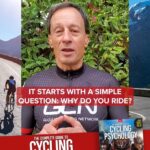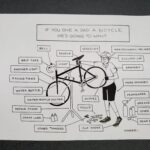In my last post, I introduced you to the importance of intensity in your cycling. I indicated that all of the mental preparation in the world will go for naught if you are not also physiologically prepared to ride your best on race day. After a good pre-race warm-up on your bike or trainer, reaching your ideal race intensity is essential.
The challenge for intensity in cycling is that different types of races and even different points in a race require different levels of intensity. Sometimes you need to be really relaxed, for example, during a long and flat stage, to conserve energy for an approaching climb. At other times, such as in a short criterium or during a sprint, you need really high intensity to generate power and speed.
The key is to have tools in your toolbox that you pull out to get to that ideal intensity when you need to.
Psych Down Tools
It’s natural to feel some increase in your intensity before a race. You’re putting yourself to the test and want to do your best. But when that intensity turns to anxiety that can hurt your performances, that can be a problem. Anxiety creates muscle tension, inhibits oxygen intake, and just makes you feel physically uncomfortable, all of which will slow you down on your bike.
But rather than just resigning yourself to feeling nervous and having a bad ride, you can take active steps to reach and maintain your ideal intensity so you can ride your best. There are a number of simple psych-down techniques you can use to get your intensity back under control.
Deep breathing. When you experience overintensity, one of the first things that’s disrupted is your breathing. It becomes short and choppy and you don’t get the oxygen your body needs. The most basic way to lower your intensity then is to take control of your breathing by taking slow, deep breaths.
Deep breathing has several important benefits. It ensures that you get enough oxygen so your body can function well. By getting more oxygen into your body, you will relax, feel better, and it will give you a greater sense of control. This increased comfort will give you more confidence and enable you to more easily combat negative thoughts (which are often the cause of the overintensity). It will also help you let go of negative emotions, such as fear or frustration, and allow you to regain positive emotions such as excitement. Focusing on your breathing also acts to take your mind off of things that may be interfering causing your overintensity.
Taking conscious deep breaths before the start of a race is a simple and easy way to settle yourself down and prepare for the start. More deep breathing during races, for example, as you prepare for a climb, can also help you reach and maintain your ideal intensity.
Muscle relaxation. Muscle tension is another common symptom of overintensity. This is the most crippling physical symptom because if your muscles are tight and stiff, you simply won’t be able to ride at your highest level. There are two muscle-relaxation techniques you can use before and during a training ride or ace: passive relaxation and active relaxation. Similar to deep breathing, muscle relaxation is beneficial because it allows you to regain control of your body and makes you feel more comfortable physically. It also offers the same mental and emotional advantages as does deep breathing.
Passive relaxation involves simply focusing on your muscles and allowing them to relax. Active relaxation is used when your body is very tense and you can’t relax your muscles with passive relaxation. When your intensity is too high and your muscles are tight, it’s difficult to just relax them. So instead of trying to relax your muscles, do just the opposite. Tighten them for five seconds, then relax them.
Active relaxation typically involves tightening and relaxing four major muscle groups: face and neck, arms and shoulders, chest and back, and buttocks and legs. It can also be individualized to focus on particular muscles that trouble you the most. The neck and shoulders seem to be the important muscle groups for cyclists because if those muscles are tight, your center of gravity rises and your power and stamina decreases.
Music. Music is one of the most common tools cyclists can use to control their intensity. We all know that music has a profound physical and emotional impact on us. Music has the ability to make us happy, sad, inspired, and motivated. Music can also excite or relax us. Many professional cyclists listen to music before they compete to help them reach their ideal intensity.
Music is beneficial in several ways. It has a direct effect on you physically. Calming music slows your breathing and relaxes your muscles. Mentally, it makes you feel positive and motivated. It also generates positive emotions such as joy and contentment.
A word of caution. Though listening to music through ear buds is increasingly common on the road these days (probably half the riders I see in Marin County), I recommend against it. First, for obvious reasons, it can be dangerous because you won’t hear an approaching car, a honk, or a word of warning from a riding buddy. Music can distract you from focusing on the quality of your ride. It can also prevent you from listening to the messages your body is sending you about exertion and pace.
Smile. The last technique for lowering intensity is one of the strangest and most effective I’ve ever come across. A few years ago, I was working with a young professional cyclist who was having a terrible training ride. He was riding poorly and his coach was getting frustrated with him. He dropped back to me feeling angry and depressed, and his body was in knots. He asked me what he could do. I didn’t have a good answer until an idea just popped into my head. I told him to smile. He said, “I don’t want to smile.” I told him to smile. He said he was not happy and didn’t want to smile. I told him again to smile. This time, just to get me off his back, he smiled. I told him to hold the smile. During the next two minutes there was an amazing transformation. As he rode along with the smile on his face, the tension began to drain out of his body. His breathing became slow and deep. He said that he was feeling better. In a short time, he was looking more relaxed and happier. He returned to his training pace, his riding improved, and he made some progress during the remainder of ride.
His response was so dramatic that I wanted to learn how such a change could occur. When I returned to my office, I looked at the research related to smiling and learned two things. First, as we grow up, we become conditioned to the positive effects of smiling. In other words, we learn that when we smile, it means we’re happy and life is good. Second, there’s been some fascinating research looking at the effects of smiling on our brain chemistry. What this research has found is that when we smile, it releases brain chemicals called endorphins which have an actual physiologically relaxing effect.
Psych Up Tools
Though less common than overintensity, letdowns in intensity can also cause your level of riding to decline. A decrease in intensity causes all the things that enable you to cycle well to disappear. Physically, you no longer have the blood flow, oxygen, and adrenaline necessary for the strength and stamina you need to ride your best. Mentally, you lose the motivation and focus that enables you to cycle well. Just like psych-down tools when your intensity is too high, you can use psych-up tools to raise your intensity when it drops.
Intense breathing. Just as deep breathing can reduce intensity, intense breathing can increase it. If you find your intensity dropping, several hard exhales can take your body and your mind to a more intense level. It’s a useful practice before a race to take two intense breaths. It’s also a great cue during races to amp up your intensity as, for example, you approach a difficult climb (think Chris Froome) or a sprint finish (think Marc Cavendish). I encourage you to make intense breathing a consistent part of your training and race efforts.
High-energy self-talk. One of the main causes of drops in intensity is letdown thoughts. Thinking to yourself, “I’ve got this won,” “I’ve bonked,” or “I can’t believe I’ve been dropped,” will all result in your intensity decreasing because your mind is sending messages to your body that it no longer needs to put out effort. When this happens, you can be sure your riding will decline. When you start to have these thoughts, you need to replace them with high-energy self-talk. Self-talk such as “Keep attacking!,” “Go, go go!,” and “Stay pumped!” will keep you motivated and focused, and your body will respond with more intensity.
High-energy body language. It’s difficult using high-energy self-talk without also having high-energy body language. Pumping your fist or slapping your thigh will also get you fired up and will increase your intensity.
Music. As I noted above, music has a profound physiological and emotional impact on us. Music can be used to raise your intensity and get you more psyched up and motivated. The over-all sensation of listening to high-energy music (e.g., rock, hip-hop) is a generalized sense of excitement and energy.
Key Race Situations
There are common race situations in which you can expect that your intensity will shift away from its ideal level. If you can identify these situations when they occur, you can more quickly take steps to prevent a change in intensity that may hurt your riding. These race situations usually relate to when you’re either ahead or behind in a race, or the race is on the line.
Overintensity is most common in pressure situations such as during a challenging climb or a sprint finish. Both scenarios can make or break a race and this pressure can cause your intensity to go way up, the exact opposite reaction that you want to have happen.
Underintensity is seen most often in race situations in which you believe you can win, for example, you have a big lead, or you think you have no chance of achieving your goal, such as when you get dropped by the peloton. In the former case, your mind tells your body that you have already won (even though you haven’t) and this message causes your body to think it can shut down now. In the latter case, you are giving up mentally, so you’re telling your body there is no reason to keep trying.
There is not, however, a consistent pattern in how intensity will change for all cyclists. Riders in the same race situation can experience different changes in intensity. For example, when within sight of a victory, one rider may have an increase in intensity and feel very nervous because he’s never won a stage before and doesn’t totally believe that he can this time. While another rider in the same situation might have a decrease in intensity and feel a letdown because he’s already mentally at the finish accepting his trophy. You have to figure out how you typically react and then use the psych-up and psych-down tools I just described to achieve and maintain ideal intensity.
For all of these psych-down and psych-up tools to be effective, you should practice them during training rides and in less important races. The goal is to ingrain them so well that when you get to a major event where you are likely to either get nervous or experience a letdown, you will automatically use them, your intensity will shift to its ideal level, and you will be in a better position to ride your best.






